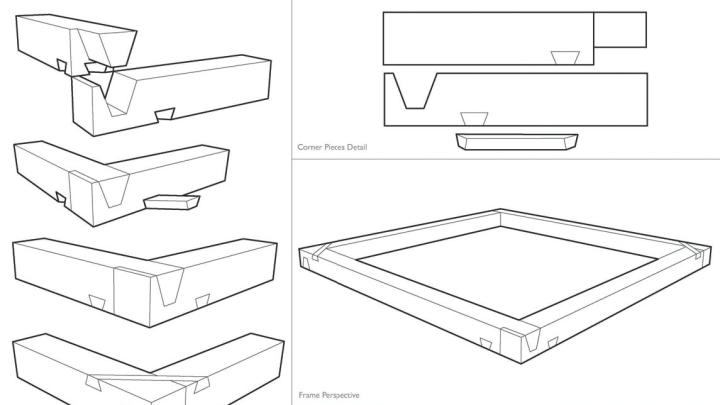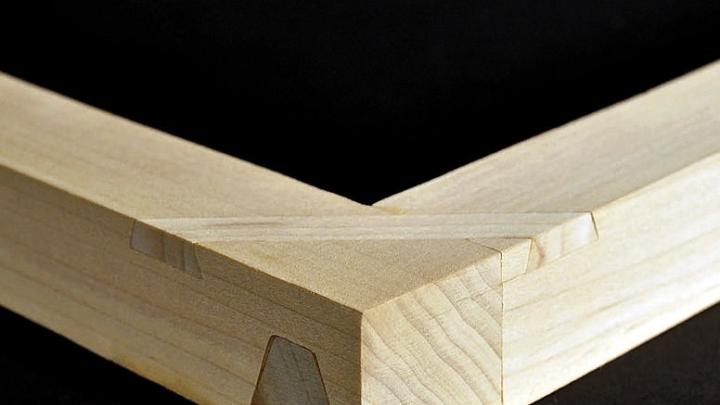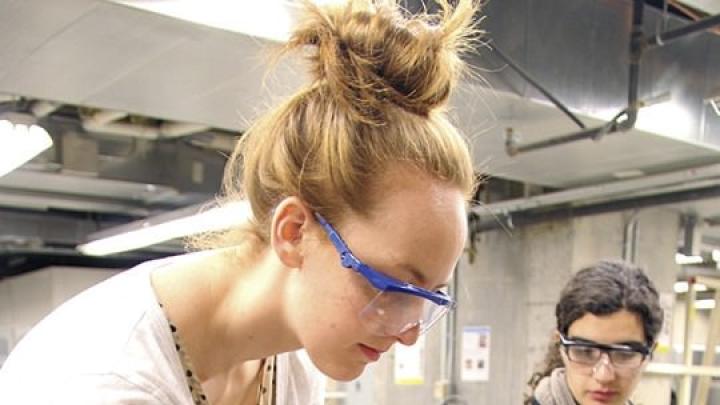At the start of their undergraduate architecture lab this fall, Mark Mulligan and Michael Smith gave their students an assignment that seemed like something out of a high-school shop class: take two pieces of wood, and make a joint. But before the students sat down to plan their projects, Mulligan and Smith had lectured on subjects ranging from the physical properties of the material to the cultural legacy of Japanese wood joinery, revealing the depth that even such a modest project could contain. By the end of the week, students had moved to the woodshop in the basement of Gund Hall to build the plans they’d sketched, fulfilling for the first time the hands-on component promised in the course’s title—HAA179x: “Construction Lab.” Soon, the principles of design and history they had learned earlier met with a very different understanding of what’s possible in a world with gravity and human error. “They draw and think up these things” that can be quite intricate, says Smith, a lecturer in architecture. “But then they’re presented with the material, and the whole world changes.”
These three streams—history and theory, design imagination, and the physical act of making—are the central components of the undergraduate track in architecture studies, a joint program from the Graduate School of Design (GSD) and the Faculty of Arts and Sciences’ (FAS) department of history of art and architecture. It took years of planning on both sides—including “literally two years of meetings”—to get the program off the ground in the fall of 2012, explains Noyes professor of architectural theory K. Michael Hays, the GSD’s associate dean for academic affairs. The first students in the track, housed within the art-history concentration, graduated last spring.
The GSD-FAS collaboration represents what Hays calls “a new band of knowledge” for the College, offering undergraduates the first real chance to take advantage of the GSD’s offerings. Yet those involved in the program’s creation harbor an even bigger ambition—to make the case that design thinking, beginning with architecture in particular, is an invaluable form of liberal-arts inquiry. “The study of architecture, in a broad sense, is a study of culture itself, and in some ways is a mode of knowledge,” says Hays, one of the GSD’s leading boosters of the new track. To illustrate, he points to a student in one of the first classes, who switched from her original concentration in philosophy. “She told me, ‘I came here knowing that I could think. I didn’t know that I could make things, and I certainly didn’t know I could think by making things.’”
In Mulligan and Smith’s construction lab, the professors like to remind students of these possibilities for deeper thinking and engagement, even as they focus on the technical problems at hand. Mulligan, an associate professor in practice of architecture, explains that students need to remember that joints do more than just hold two pieces together. They can express a sense of rigidity and solidity on one hand, or lightness and even tenuousness on the other. “People don’t think of technology courses as being focused on beauty or aesthetics,” he says. “But that’s actually where everything intersects.”
These connections among design, aesthetics, and technology is a central component of the studio, a type of project-based course that traditionally lies at the core of architectural pedagogy. At Harvard, the new track asks undergraduates to complete a two-course sequence of design-oriented intensives. The courses are housed in a dedicated classroom on the top floor of Gund, refurbished with a grant from the Harvard Initiative for Learning and Teaching. With a 3-D printer and a series of highly connected monitors, projection surfaces, and motion sensors, the room serves as a lab for teaching, using the students as guinea pigs to discover how technology can enhance studio instruction. These are important questions, Hays argues, because “studio learning is not vocational learning, but is actually a way of producing knowledge that’s different from, but equal to, textual knowledge and reading and writing.”
New concentrators begin with “Transformations,” a studio that focuses on “the development of a common language”—of surface, frame, volume, and composite—according to Zaneta Hong, a lecturer in landscape architecture who taught the course for the past two years. Like Mulligan and Smith, she begins the semester with the simplest of transformations: folding a piece of paper in half. From there, students learn technical skills like digital modeling and laser cutting, and incorporate new materials like Plexiglas™ during the semester. What they never get in this first studio is an assignment to design what most people think of as architecture—a structure to be inhabited, on a site, with a specific use or “program.” Even the final project remains abstract, the only guideline being to “transform” paper, museum board, and Plexiglas™, within the constraints of a five-by-five-inch model. “The luxury to be able to focus solely on the design aspects is a good thing to do for a little while,” says Angie Jo ’16, who took Transformations last spring. “I never could have expected that you could get so much conversation, so much thought and creative iterations, out of such a small seed.”
The second required studio, “Connections,” introduces students to more real-world concepts of scale and interactions. Hong will teach the studio this spring; she plans to move students along through different levels of intervention: beginning with the artifact, moving on to the assembly and construction of an actual space, and finishing with a consideration of the urban and even global scale.
Though Connections will present students with the kinds of problems central to more traditional architecture studios, Hong says that both courses in the sequence are hard to compare to the core, graduate-level studio courses offered at the GSD—which meet for 12 hours each week, twice the time commitment of Connections—or in undergraduate professional programs approved by the National Architectural Accrediting Board. The latter tend to be intensive, five-year plans of study: Cornell’s B.Arch. program includes 10 semesters of studio. Harvard’s new track requires far fewer studio courses, even, than similar nonprofessional undergraduate programs (whose graduates, like Harvard’s, must later earn master’s degrees in order to practice as an architect). At the University of Virginia, where Hong used to teach, the “preprofessional” concentration within the four-year B.S. in architecture degree requires four “foundational studios” and an additional three “research studios.” (Hays says he hopes to eventually offer a third studio, but it would remain an optional, senior-year “capstone” for interested students.) But the track’s pair of studios are two elements in a general education that could hardly be considered intensively preprofessional. Rather, Hong says, they’re meant to establish students’ baseline interests in architecture, landscape architecture, or urban planning.
Students’ interests have already created an appetite for more intensive design learning, creating both opportunities and tensions as the track keeps one foot firmly planted in the College’s liberal-arts tradition. Beyond studios, students fill in their track requirements with other courses in both art history and the GSD. During the past two years, several new offerings have been created to accommodate them, including an architectural history and theory tutorial in FAS, and an undergraduate-only section within a standard GSD course (“Buildings, Texts, and Contexts I,” taught by Hays and professor of architectural history Erika Naginski).
Mulligan and Smith’s Construction Lab, first offered in the fall of 2013, extends a seven-week intensive boot camp for students entering the GSD’s master’s of architecture program. Mulligan recently served as faculty administrator of that program; he knows the kind of skills that entering graduate students have, and has translated that knowledge to the undergraduate level. The course feels intentionally unprogrammed: assignments ask students to think about concepts like equilibrium and inhabitable space in ways that are often more sculptural or technical than overtly architectural. “The best thing we can do,” he explains, “is to try to prepare them, their way of learning and their way of being self-critical, without necessarily engaging directly in conventional architectural projects—like, design a shelter of some kind.”
Students say their dual identities as art historians and potential budding architects have offered a unique and unexpected opportunity. Several have taken part in their department’s annual sophomore-excursion course, which included a trip to Amsterdam last spring. Thomas professor of the history of art and architecture Joseph Koerner, the director of undergraduate studies within the department, says that having students with studio architecture experience has deepened conversations in more traditional classes. “The study of art is very much enhanced by seeing people around you participating in the kinds of constructive thinking and making that [exist] in the works” a course might tackle, he explains. Outside class, some have even found a home in a new building on campus that marries their interests in the study of art and the practice of architecture—the Harvard Art Museums, designed by Pritzker Prize-winner Renzo Piano. Four of the 18 student tour guides whom the museum hired this fall are affiliated with the architecture track; they say they like the challenge of learning to talk about the building’s architecture to an audience that may not have thought seriously about design before. Angie Jo, who had considered art school before coming to Harvard, says she decided to become a student guide because learning to speak authoritatively about design, and make the case for its importance to a general audience, will be an important part of her future as an architect.
Jo hopes to apply to architecture school, and acknowledges that the track’s interdisciplinary nature has provided fewer opportunities for projects to include in an application portfolio. But the upside of the concentration’s lighter studio requirement is “vastly more time to contextualize it all.” She has begun to focus her studies on the ethical and social aspects of design practice. The Harvard program, she says, “feels very much like architecture studies to me, rather than architecture or design.”
The study of architecture, from Hays’s perspective, has relevance to the wider student body in much the same way that the study of literature does. Perhaps the best case for his argument is the number of nonconcentrators who have enrolled in the architecture track’s design courses. Enrollment was limited to concentrators when Transformations and the Construction Lab were first offered, but enrollment has essentially doubled since that restriction disappeared. This semester, Mulligan and Smith have students from East Asian studies, film, and applied math in their course. Gianina Yumul ’16, a member of the architecture-studies track who came to Harvard intending to study astrophysics, says she appreciates the course’s almost accidentally interdisciplinary nature. She speaks enthusiastically about working in groups with a student from applied math: “He has this other language that, when applied to architecture, produces something really beautiful and unexpected.” His professors say they hope influence can also flow in reverse: that the spatial awareness of architecture will give this student new tools with which he can better understand math.
For Hays, that kind of cross-disciplinary connection is an exemplar of what his dream of linking the GSD and the College could spark. Though the program currently focuses on architecture, he hopes it will be expanded to a stand-alone concentration, still jointly administered with the art history department, that could encompass the different kinds of design that play significant roles in today’s world, including graphic and industrial design and urban studies (already, FAS’s 2013-4 annual report hints at the possible creation of an interdisciplinary secondary field in urban studies). Several GSD professors noted that, in their ideal world, the track would attract students beyond those headed for design school—just as literature concentrators don’t all become professors, and engineering concentrators don’t all become licensed engineers. Instead, the program’s graduates could become policymakers with an informed understanding of the built environment, or engineers with a sense for the aesthetic choices inherent in all their decisions. As Hong puts it, “Design has no boundaries. It permeates through any kind of profession.”










